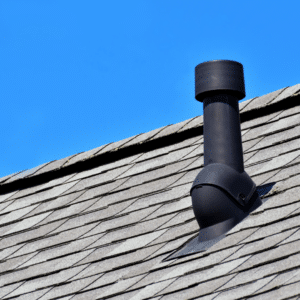Proper roof ventilation is a critical aspect of safeguarding your home against the devastating effects of wildfires. By ensuring effective ventilation, you create a proactive defense mechanism that can significantly reduce the risk of your roof catching fire during a wildfire.
There are several key ways in which proper roof ventilation is essential during a wildfire. It facilitates heat dissipation, aids in ember mitigation, helps control smoke dispersal, and acts as a vital fire barrier.
The Significance of Roof Ventilation in Wildfire Defense
Proper roof ventilation stands as a critical defense mechanism against the destructive forces of wildfires. Its significance lies in its ability to prevent the attic from becoming a pressure cooker, where intense heat can ignite combustible materials within the home. By facilitating heat dissipation, roof ventilation significantly reduces the risk of attic fires, making it an indispensable element of fire safety.
In recent years, the threat of wildfires has surged, fueled by climate change, prolonged droughts, and human activity in wilderness areas. This escalating danger underscores the importance of effective roof ventilation in safeguarding homes. Inadequate ventilation can lead to rapid attic overheating, ember-related roof ignitions, indoor smoke accumulation, and external flames breaching the interior. Recognizing these potential consequences reinforces the urgency for homeowners to prioritize proper roof ventilation as a vital component of their wildfire defense strategy, ensuring the protection of their homes, loved ones, and peace of mind in the face of an increasingly perilous wildfire landscape.
Key Ways Roof Ventilation Shields Against Wildfires
Heat Dissipation
Proper roof ventilation is essential during a wildfire because it helps in several key ways. First and foremost, it facilitates heat dissipation. Picture this: a wildfire rages nearby, sending scorching heat and flames into the air. Without adequate roof ventilation, your attic can become a pressure cooker, with temperatures soaring to dangerous levels. When the attic becomes superheated, it’s a recipe for disaster, as it can ignite combustible materials within your home.
Dissipating heat through roof ventilation is achieved by creating an airflow that allows hot air to escape from the attic. This is typically accomplished by using intake vents at the lower portions of the roof and exhaust vents near the roof’s peak. The intake vents draw in cooler outdoor air, which then pushes the hot air out through the exhaust vents, effectively reducing attic temperature and minimizing the risk of heat-related ignition during a wildfire.
Ember Mitigation
Another critical role that roof ventilation plays in wildfire defense is ember mitigation. During a wildfire, embers are carried by the wind, sometimes for miles. These fiery embers can land on your roof, in your gutters, or anywhere else they can find a home. If your roof lacks proper ventilation, these embers can settle there, potentially igniting your roof and leading to disaster.
Ember mitigation through roof ventilation relies on the principle of airflow control. Properly designed ventilation systems ensure that the incoming air creates a positive pressure within the attic space, pushing outwards rather than allowing embers to infiltrate. This controlled airflow acts as a protective barrier, reducing the risk of ember ignition and enhancing the overall resilience of your home during a wildfire.
Smoke Control
Effective roof ventilation is not only about preventing fires but also about controlling smoke. Smoke during a wildfire can be thick and suffocating, making it difficult to breathe and see. It’s a safety hazard that affects both your health and your ability to evacuate if necessary.
Smoke control through roof ventilation is achieved by creating an escape route for smoke to exit the attic. Well-designed ventilation systems include exhaust vents that allow smoke to be carried away by the controlled airflow, preventing it from accumulating within the attic space. This proactive approach to smoke control maintains better indoor air quality and visibility during a wildfire. This can be a lifesaver, allowing you and your family to breathe more easily and navigate your home safely.
Fire Barrier Function
A ventilated roof doesn’t just help with heat, embers, and smoke; it also acts as a vital fire barrier. When a wildfire approaches, the heat can be intense, and flames can leap from treetop to treetop, sometimes reaching the exteriors of homes. Without proper ventilation, your roof can become vulnerable to these external flames.
The fire barrier function of roof ventilation hinges on its ability to maintain a cooler attic environment. By dissipating heat and expelling embers, well-ventilated roofs create a less conducive environment for fire propagation. This creates a protective buffer that reduces the risk of external flames breaching the interior, contributing to the overall fire resilience of your home.
How to Achieve Effective Roof Ventilation
Now that we’ve recognized the pivotal role of roof ventilation in wildfire defense, consider these several practical methods to ensure effective ventilation for your home:
- Ridge Vents: These vents are installed along the peak of your roof, providing continuous ventilation.
- Soffit Vents: Positioned under the eaves, soffit vents allow fresh air to flow into your attic.
- Gable Vents: Placed in the gable walls of your home, these vents create airflow through the attic space.
- Whole-House Fans: While not roof vents, whole-house fans help with overall ventilation by expelling hot air from your home.
- Proper Insulation: Combining adequate insulation with ventilation creates an effective temperature control system.
The choice of ventilation strategy should be tailored to your home’s design, local climate, and the wildfire risk in your area. Consulting with a roofing professional is advisable to determine the best approach for your specific situation.
Maintenance and Inspection
To ensure your roof ventilation system operates effectively in wildfire defense, follow this comprehensive checklist for regular maintenance and inspections:
- Clear Debris: Regularly remove debris, leaves, and obstructions from vents to maintain unobstructed airflow.
- Inspect for Wear: Periodically check vents for signs of wear, corrosion, or damage, addressing any issues promptly.
- Assess Insulation: Ensure proper attic insulation to prevent heat buildup, which can strain the ventilation system.
- Prompt Leak Repairs: Address roof leaks promptly to prevent damage to the ventilation system and maintain its integrity.
- Professional Inspection: Schedule regular inspections by a qualified roofing professional to assess the overall condition of your roof and ventilation system.
By following this checklist, you can proactively maintain your roof ventilation system, enhancing its performance in wildfire defense and ensuring your home’s safety.
Is roof ventilation only necessary in areas with a high wildfire risk?
No, roof ventilation is beneficial for homes in various regions, not just those with a high wildfire risk. While it plays a crucial role in wildfire defense, it also offers advantages in terms of temperature control, energy efficiency, and prolonging the life of your roof.
In wildfire-prone regions, roof ventilation isn’t just a nice-to-have; it’s a must-have. It serves as a crucial line of defense against the destructive forces of wildfires, offering protection from heat, embers, smoke, and external flames. Protect your home and loved ones from the risks of wildfires and ensure your roof ventilation is in optimal condition. Schedule a professional roof inspection with Just Roofs and Gutters to assess the effectiveness of your ventilation system.





